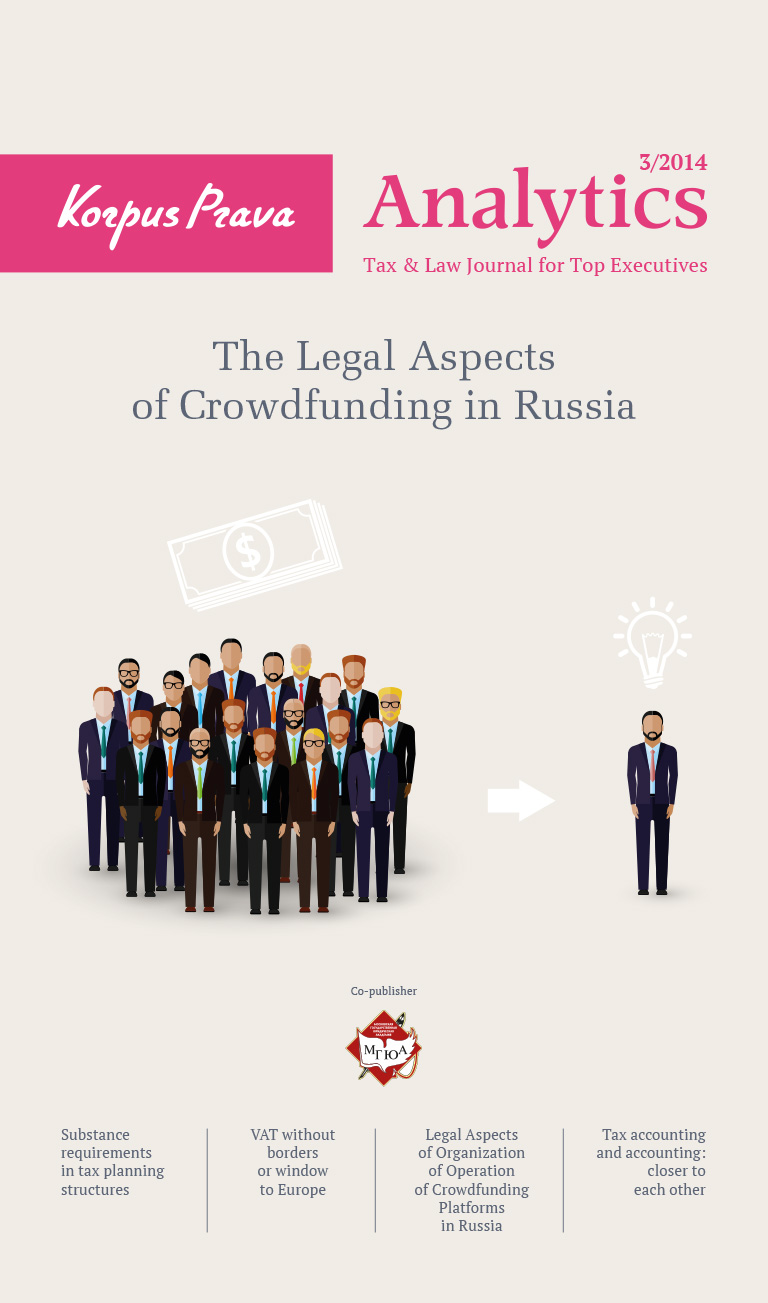- Cyprus Citizenship Scheme for Foreign Investors
- Squeezed But Pleased: Taxation of Passive Income in the European Union
- VAT Without Borders or Window to Europe
- Legal Aspects of Organization of Operation of Crowdfunding Platforms in Russia
- Substance Requirements in Tax Planning Structures
- “Deposit Splitting” of Individuals. Legal Civil and Criminal Aspects
What to Know Before Getting into ICO
The hype around ICO grows with each passing year and attracts not only a limited number of people connected in any way with the world of digital technologies, but also those people who have never associated themselves with one.
On the one hand, the appeal for investors is explained by the promised super-efficiency of projects. On the other hand, projects discovered a new instrument for attracting limitless investments.
In practice ICO participants face a great number of issues related to legal regulations, technical support and business planning. The main goal for a participant is to clarify all these issues in time. It is important for investors to be able to estimate investment potential of the project, and it is necessary for projects to ensure their feasibility and competitive ability in the market.
Let’s start with the basics: what is ICO?
ICO (Initial Coin Offering) is an actual emission of tokens for payment purposes by any project. In other words, a project issues its payment instrument which will be acceptable in its ecosystem.
What is the “project” that issues tokens? It is a certain issuer, generally, a legal entity.
Traditionally, at the basis of any project there are founders with their original idea. It is much easier to administer a project through a legal entity where creators also act as founders (shareholders). Therefore, founders face certain issues related to the establishment and functioning of this legal entity, specifically.
Incorporation jurisdiction
Upon choosing jurisdiction, one should consider numerous aspects, both obvious (such as tax planning, incorporation cost and maintenance cost) and seemingly unobvious (complicated implementation of corporate procedures and protection from fraud). For example, company incur, and quickly implement corporate procedures. However, under certain off-shore jurisdictions the obligation to keep the shareholder register is vested upon the company director, rather than state authorities, therefore, shareholders fully depend on bona fide of the company administrator.
Correlation between control and equity share held by shareholders
This means not only the number of stocks or equity shares, but a right to influence company decisions (shares may be voting/non-voting).
Profit distribution procedure
As a rule, standard forms of incorporation documents provide for profit distribution pro rata shares held, however, alongside with ordinary shares one may issue preference shares, and although holders thereof have no votes, they have first claim to company dividends.
Shareholders’ agreement
This agreement serves as an additional instrument to secure inner arrangements between shareholders.
Options
In certain cases there is a need to attract large investors to the project by giving them an opportunity for equity participation in future, rather than providing them with tokens. In this case, such instrument as an option agreement may be appropriate.
Furthermore, given the commercial objective of the project, the company obviously needs to open a bank account in order to settle payments with counterparties. Nowadays, opening bank accounts is not an easy task. As a rule, apart from a standard set of company documents, banks request information on counterparties, business plan, estimated cash flows, etc. Thus, the more accurate the project planning is the easier and faster it is to open a bank account. It might be reasonable to collect information on the bank’s business reputation, availability of payment settlement with potential counterparties (certain banks do not settle payments from Russia).
Obviously, apart from the so-called fiat money in banks and crypto-assets in e-wallets, the company is supposed to have other assets (tangible: office, servers; intangible: website, logo/trade mark, etc.). Consequently, there is a great number of issues from economic efficiency of renting an office and acquiring servers to the protection of intellectual property rights, represented specifically by a trade mark, website content.
In view of the above, any project needs to prepare a business plan for ICO, which would contain general issues related to project objectives, its market mission, original nature, as well as specific goals (for example, minimal viable product, budget plan, estimated use of tokens in the ecosystem, token value).
Token economics (or the widely used Internet term tokenomics) is very important, because a token may be accepted as:
- Prepayment for goods/works/services, for example, a platform sells its tokens, and one may acquire something at the same platform using these tokens (such tokens are known as utility tokens);
- Security (security tokens), in this case a project offers to acquire a token, and in future an investor is granted a right to profit. In this case a project will have to comply with the regulation of the securities market depending on the jurisdiction of the issuer and investors. Here one may apply some knowledge of Howey Test and other similar tests.
Despite the free scope for imagination caused by the absence of precise international ICO regulation, there are tried-and-tested practice guidelines that make it possible to implement ICO and various projects.
Particularly, legal framework for ICO includes the following documents:
- Whitepaper is a document posted on the project website, which is available for general public and includes marketing research of similar products in the market, describes the mechanics of the project and its advantages, answers the question of its innovative nature. Given the fact that investors may have different levels of knowledge and the whitepaper is quite a complicated document, which describes various aspects of the project, certain websites offer several versions of it, e.g. full version and short version (containing basic principles and schemes).
- Roadmap is a document posted on the project website, which is available for general public and gives an overview of the process history: emission, token circulation and project implementation, growth rate.
- Token sale agreement is a document posted on the project website, which is actually a sale and purchase agreement for tokens.
- Terms and conditions, in order not to complicate a token sale agreement, basic terms and conditions of offering, circulation, etc. are set out in a separate document.
- Consent to personal data processing is a document posted on the website and signed individually by each investor.
- Data protection policy is a document posted on the website, which allows investors to learn about the protection policy for submitted personal data.
- Legal opinion on the token nature is an in-house document for an issuer, which specifies the legal nature of the token (utility\security).
- Cyber security audit procedure is the information on the procedure, choice of auditors (dependent/independent); posting of the auditor’s report is possible.
First two documents shall contain information on the token distribution procedure and give a clear idea on the token emission and circulation process, including:
- Total amount of tokens;
- Amount of tokens planned for ICO;
- Amount of tokens planned for holding up by the team and restrictions;
- Offering period;
- Restrictions for investors;
- Soft cap / hard cap;
- Stock exchange listing (if any), list of stock exchange (if any);
- Risk hedging.
Without any doubt, innovative nature and absence of similar ideas has no small share in the project success, however, these are not the only details project creators and investors should consider. They both should acknowledge risks that arise from the absence of national and international regulation of this sphere, as mentioned already in this article. On the one hand, it gives freedom to implement projects, but on the other hand, it provides no protection of investors’ or project founders’ interests.
Investors risk investing money in a non-viable or fraudulent project (scam), which aims to attract funds with no further development of its goal.
Besides, project creators may deem involvement of technical, law or marketing specialists as excessive, and may prefer taking a chance and hoping that their idea is good enough by itself. In this case there is a risk that a project will not attract enough investments, as after seeing the project’s “cover” investors may deem this project as untrustworthy or unpromising. But even if they managed to attract enough funding, it is far more difficult and costly to adjust ill-conceived aspects along the way, for example, if the issuing company is registered under inappropriate jurisdiction. Moreover (which is generally overlooked in the initial stage, because at that point project creators have nothing to share, but only have an inspiring idea that unites all project participants), if the idea is really good and the project generates profit, there appears an urgent need to share responsibilities and powers to make key decisions. In the company this process is regulated by incorporation documents at best, so parties have to appeal to courts, which not only entails significant litigation expenses, but also hinders the ordinary course of project.
Apart from the above-mentioned economic risks, there are risks of administrative or criminal liability.
In view of the above, it is important to prepare the project to ICO with care before entering the market. Nowadays, ICO has proved itself as an efficient technique of investment attraction, but the future of this technique depends a lot on its legal regulation both on the state (national) and international levels.
Your subscription to our journal will definitely boost the efficiency of your specialists and downsize your expenses for consultants.
The journal is available free of charge in the electronic version.
Free Download

